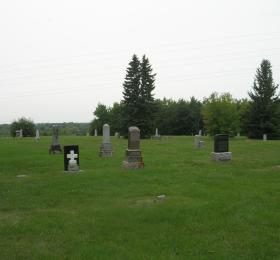Pioneer Cemetery
- Designated
Description of the Historic Place
The Pioneer (Nutana) Cemetery is located on the scenic eastern bank of the South Saskatchewan River in the Exhibition neighbourhood of Saskatoon. The cemetery covers 5.6 hectares, consisting of grass-covered interment areas marked by a cairn, tombstones, natural vegetation, footpaths and a scattered planting of trees.
This historic place, located at Ruth Street West and St. Henry Avenue, was designated as a Municipal Heritage Property in 1982.
Heritage Value
The heritage value of the Pioneer (Nutana) Cemetery lies in its association with the early settlers of Saskatoon. A central cairn honours this resting spot of persons who succumbed to prairie hazards such as prairie fire and snowstorms, as well as casualties of the Riel Resistance. The Clark, Trounce, Fletcher and Caswell surnames are among the notable pioneer Saskatoon families represented on inscribed tombstones. With the first interment occurring in the spring of 1884, the cemetery was the community’s first and for two decades, only cemetery. While the exact number of interments is unknown, 162 interments in total have been documented.
Impassable roads, the loss of early cemetery records and the instability of the riverbank were factors leading to the creation of a new cemetery. In 1910 the City of Saskatoon took over management of the Cemetery from the Pioneer (Nutana) Cemetery Company, and only those who already owned plots or had family buried there could use it. The last burial occurred in the Pioneer (Nutana) Cemetery in 1948.
The heritage value of the Pioneer (Nutana) Cemetery also resides in its landscape design. Located far beyond the original Temperance Colony settlement, its location was chosen for its dramatic and placid river view. Except for changes caused by river erosion, the cemetery is one of the last remnants of natural prairie landscape within the boundaries of the city.
Source: City of Saskatoon Bylaw No.6210 / City of Saskatoon Built Heritage Database / Canadian Register of Historic Places
Character Defining Elements
Key elements which contribute to the heritage value of this historic resource include:
- Its built features, particularly the cairn and the tombstones marking interments;
- Its natural grass cover, footpaths, and planting of trees; and
- The open view of the river valley on its west.

